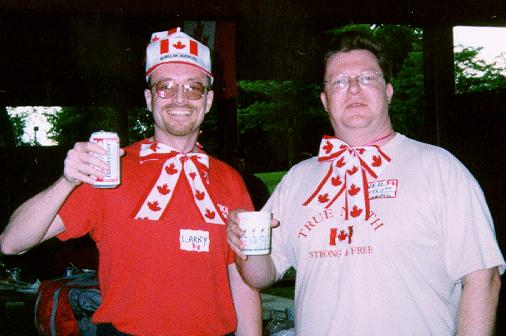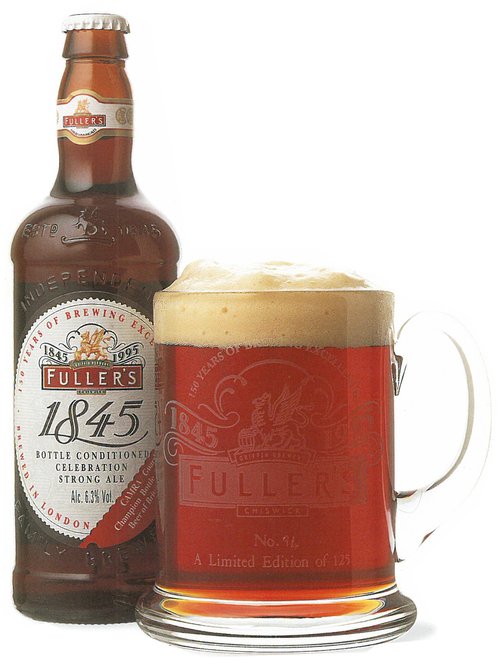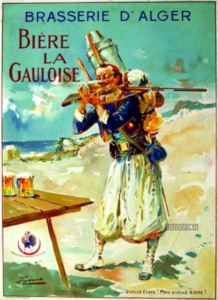 It’s that special time of year, the middle of the year, when those two guy up there often reappear. It’s Canada Day week. I can’t be sure when they first appeared on this here blog but nine years ago I said it was nine years before that. Back then I was writing political posts on the now merged blog Gen X at 40* and I had a whole schtick in 2005 about a future where the Maritime Provinces of Canada was working towards breaking away to be an independent nation based on graft and hydrofoil ferry services. The identity of these two gents is lost to time or at least just lost to my mind so if it is you say hello! And remember… for all your Canadian beer news read Canadian Beer News!!
It’s that special time of year, the middle of the year, when those two guy up there often reappear. It’s Canada Day week. I can’t be sure when they first appeared on this here blog but nine years ago I said it was nine years before that. Back then I was writing political posts on the now merged blog Gen X at 40* and I had a whole schtick in 2005 about a future where the Maritime Provinces of Canada was working towards breaking away to be an independent nation based on graft and hydrofoil ferry services. The identity of these two gents is lost to time or at least just lost to my mind so if it is you say hello! And remember… for all your Canadian beer news read Canadian Beer News!!
Top beer news of the week from the land of canoes and maple syrup? Toronto municipal bureaucracy!
The proposed pilot, which will be considered by the Economic and Community Development Committee on July 6, comes after city council directed staff to create a pilot program last month to allow residents to drink in select public parks this summer. If approved, recommendations will go to city council July 19. The program would run from Aug. 2 until Oct. 9 and allow people aged 19 and older to drink alcohol in 20 city-owned parks in neighbourhoods where local councillors chose to opt in. Toronto councillors had the option to opt out of the program entirely, making parks in their area off-limits when it comes to drinking in public.
You know, we are not so much prudish in Canada as waiting for our grade four teacher to come back into the class to tell us what to do next. Consider the approach of our Commonwealth sibling Australia in this regard on a similar issue:
No worries about spectators getting a beer at the stadium when Australia hosts the 2032 Olympics. “We’ll serve a beer because we can,” Brisbane organizing committee president Andrew Liveris said Wednesday when asked about an alcohol prohibition for ordinary fans at the 2024 Paris Olympics.
In Commonwealth HQ, Boak and Bailey published** a magnificient piece of work entitled “Henekey’s Long Bar and the birth of the pub chain” – effectively an addendum to their excellent 2017 book 20th Century Pub. The story neatly begins are the beginning:
The building was probably built in the 17th century, although a plaque on the site claims there was a pub there from 1430. It was originally called The Queen’s Head Tavern or, in later years, The Queen’s Head Coffeehouse (“Frequented by professional gentlemen”). Under Henekey it came to be known as The Gray’s Inn Wine Establishment. After Henekey died in 1838, at the age of 55, the wine importing business carried on under his name. There were, however, no Henekeys involved in its running and his son, George Henekey Jr, actually set up a rival business right across the road.
PRESSES PAUSED!!!: puzzling Pompeii painting portraying possible pizza published!!
Mark LaFaro wrote quite a good but heavy piece for GBH*** this week on the topic that I had hoped I would see in October 2022, a discussion of the craft beer and drinks trade and the dangers of alcoholism:
Our experiences are not uncommon. Examples like this made it clear from the start of my career there was an ongoing pressure to try to “fit in” culturally in the alcohol industry, which meant honing a coveted skill of being able to drink heavily but still function. So, I drank. Hard. I got extraordinarily good at skirting that line between being a party animal and a professional. As my career and reputation grew, so did my alcohol tolerance.
While we are at it, Afro.Beer.Chick shared her thoughts on the progress of DEI initiatives in craft beer this week at exhibits A, B, C, D, E and…
 History corner time. Here to the left (my right) is a lovely bit of brewery record, a rough estimate of profit for 1896 for Rose’s Old Brewery at Malton, England. Click and have a look. Over 100% profit on the sale of XX ales at their tied houses. Approaching 150% profit on XXXX ales. Reminds me of when I bought Sam Adams shares back around 2001 to get their annual financial disclosures. Stunning profitability in beer during good times if it is done sensibly.
History corner time. Here to the left (my right) is a lovely bit of brewery record, a rough estimate of profit for 1896 for Rose’s Old Brewery at Malton, England. Click and have a look. Over 100% profit on the sale of XX ales at their tied houses. Approaching 150% profit on XXXX ales. Reminds me of when I bought Sam Adams shares back around 2001 to get their annual financial disclosures. Stunning profitability in beer during good times if it is done sensibly.
Now I know what goes into a new sort of Mexican lager to make them extra special:
Mexican entrepreneurs are using crickets to supplement barley in beer… La Grilla beer is being tested out in small batches in Querétaro by a local craft brewery and a company that makes gluten-free and bread products using insects. The creators wanted to prove that insects can become part of our diet even in drinks while maintaining taste…
I saw Chris Dyson’s blog pass by my newsfeed and liked this piece about Ilkley of Wharfedale in Yorkshire especially for the great level of detail:
Not far down was Bar T’at, a modern bar run by Market Town Taverns. Here there was a good range of beers on cask and keg and the welcoming, effusive lady behind the bar immediately approached to ask me what I would like. From the available cask, I went for a pint of Kirkstall Three Swords, which I have found is always a good bellwether pint when in somewhere new. The bar, which you enter via a mini flight of stairs, is split in two, with the bar itself to the right as you go in from the road, with an adjoining room with seating, which is where I went. There is an additional room below, whilst outside is an area with several tables alongside the car park of a shopping centre. The beer was pretty good, a decent NBSS 3, but I had spotted a beer from Bini Brew Co on the board, so once the Three Swords was no more, I ordered a half of their 4.3% hazy pale Under the Manhole Cover from the keg list. Now I was interested because…
There is more. Speaking of more, Stan unpacked an aspect of the ripples passing through the US craft malting trade after Skagit Valley Malt closed its doors (as mentioned hereabouts last week and discussed in detail here, here and here) and shared one maltster’s sensible caution:
What I have come to terms with is that the financing play for expansion has to jive with malt house aspirations, not the other way around. Letting the needs and requirements of the financing terms influence our goals or take undue risks is simply too reckless for me. In short, unwise ego-driven aspirations need to be replaced with modest, incremental growth strategies utilizing myriad funding options all at the same time (private capital, bank, community rounds, government program funding, and organic). It takes forever because in funding an agriculture-based business you immediately go from an ocean of financing options to a hot tub of very hard to find slow-money-minded investment partners. While customer demand is there, trying to service all of it immediately doesn’t necessarily make financial sense.
Speaking on the processes of brewing, Ed of the excellently named Ed’s Beer Spot is/was in Plzeň at the Plzeňský Prazdroj from whence he reported the following:
Next we went to see the filters. They have a kieselguhr candle filter and two 72 module cross flow filters which filter 600hl/hr of high gravity beer down to 0.45 micrometres. The filter modules are changed after 400 CIPs. Pentair is paid a fee for them by hl filtered. The cross flow filters are better quality than the kieselguhr filter but cost more.
Frankly, I think he just makes this stuff up.
Neat bit of writing this week by ATJ on his Substack site ATJbeerpubs:
Beyond, the view looked out onto lush green fields, cows the colour of dark caramel moving ever so slowly as if in a bovine trance, while behind me voices chorused from tables, and a noisy cock blackbird dashed across my nearer vision and fixed itself on a branch in a luxuriantly leafed tree. I wondered if this is a view that Dave ‘Woody’ Woodward saw when he sat he, for obviously this was a favourite spot of his for on the wooden bench his name and 1943-2006 was engraved alongside the words ‘He loved to sit on this bench’.****
And there was a lovely bit of lighter writing by Martin Flynn at Pellicle this week on the more… err… physically active part of pub life, the crawl, which includes this keen observation:
Personally, I believe crawls are best served in winter. That rush of warmth on entering a pub hits even stronger when it replaces the cheek-tingling air of a December evening. There’s also something lovely about meeting friends in the day, then emerging from your latest stop to see dusk has cloaked the rooftops and the streetlights have started their shift. That visible change bolsters the sense of setting aside time for people you care about: since you met up, nobody’s glanced at the clock.
Ah, the romance of being an international beer judge: stuck on a train station platform unable to get to the event, cold boxed pizza for dinner if you do get yourself there!
 Finally, not much to say about the mutiny not mutiny in Russia last weekend except that I saw this totally clickable image from early Saturday morning from Rostov which now captures the whole thing for me. A bleary guy in sandles looking like he’s out for his first coffee, standing mere feet away from a soldier, both probably thinking WTF. Note: sandles guy is not actually at the front which is just a handful of kilometers away. Note as well: the one Russian with the gun is trying to establish a fairer more effective system for running the war against Ukraine but he is next to a guy doing very well by the fact that the soldiers at the front are mainly conscripted from the non-Russian parts of the Russian Federation.
Finally, not much to say about the mutiny not mutiny in Russia last weekend except that I saw this totally clickable image from early Saturday morning from Rostov which now captures the whole thing for me. A bleary guy in sandles looking like he’s out for his first coffee, standing mere feet away from a soldier, both probably thinking WTF. Note: sandles guy is not actually at the front which is just a handful of kilometers away. Note as well: the one Russian with the gun is trying to establish a fairer more effective system for running the war against Ukraine but he is next to a guy doing very well by the fact that the soldiers at the front are mainly conscripted from the non-Russian parts of the Russian Federation.
One last thing! Thanks to reader jordan b. who liked this personal favourite of mine from last week:
There was something strangely pleasing about the juxtaposition of “bag of cans” and “all-you-can-puke prosecco”.
There. That’s it! I’m all over the place this week. Smoke’s back but just for a day or so they say. Which means I am not – after I type these last few words- going to attempt to throw my back out this Wednesday evening to make a tomato plant happy. I’ve a long weekend coming up for that. Strains by 10:45 am guaranteed. As for beer news, it’s now back to you all as always. Talk amongst yourselves. Write something. Something for me to read. And then write about. And also as per, you can check out the many ways to connect including these voices on Mastodon, the newer ones noted in bold:
Stan Hieronymus | The Man!
Boak & Bailey | The B² experience
Curmudgeon Ale Works | Jonathon is Brewing
Katie Mather | Shiny Biscuit and Corto
David Jesudason | “Desi Pubs” (2023) author
BeoirFest | They say “Let’s Talk Beer”
Ron Pattinson | The RonAlongAThon Himself
Al Reece AKA Velky Al | Fuggled
Jennifer Jordan | US hops historian
Alan McLeod | A Good Beer Blog (… me…)
Andreas Krennmair | Vienna beer and lager historian
Beer Ladies Podcast | Lisa Grimm and colleagues
The Bar Towel | Toronto’s chat zone for beer lovers
Chicago Beer Society | Folk in Chicago getting social over beer
Jay Brooks | Brookston Beer Bulletin
Joe Stange | Belgian beer expert, beer magazine editor
Cider Bar | Barry makes Kertelreiter cider
Laura Hadland | CAMRA historian and beer writer
Brian Alberts | US beer historian
Jon Abernathy | The Beer Site
Maureen Ogle | US Beer Historian
Lars Garshol | Norwegian Beer Historian and Kveik Hunter
James Beeson | Beeson on Beer
Carla Jean | MAINER!!!
Thandi Guilherme | Beer Ladies Podcast Co-host
Lisa Grimm | Beer Ladies Podcast Co-host
Roy of Quare Swally | Beery ramblings from Northern Ireland
Rob Talksbeer | Podcaster and Youtuber
Anthony Gladman | UK Drinks Writer
Jeff Alworth | Manna Of Beervana
Northwest Beer Guide | Fairly self explanatory… but not NW Latvia…
Evan Rail | Prague based GBH editor, freelance writer, NYT etc.
Todd Alström | 50% of the Alströms
Jacob Berg | Beer talking librarian
Anyone else? And, yes, we also check the blogs, podcasts and newsletters to stay on top of things – including more weekly recommendations from Boak and Bailey every Saturday and Stan at his spot on those Mondays! Get your emailed issue of Episodes of my Pub Life by David Jesudason on many Fridays. Once a month, Will Hawkes issues his London Beer City newsletter and do sign up for Katie’s now more occassional but always wonderful newsletter, The Gulp, too. Ben’s Beer and Badword is back! And check out the Atlantic Canada Beer Blog‘s weekly roundup. There is new reading at The Glass. Any more? Yes! Check to see the highly recommended Beer Ladies Podcast. And the long standing Beervana podcast . There is the Boys Are From Märzen podcast too and check out the travel vids at Ontario’s own A Quick Beer. There is more from DaftAboutCraft‘s podcast, too. All About Beer has introduced a podcast. There’s also The Perfect Pour. Plus follow the venerable Full Pint podcast. And the Craft Beer Channel on Youtube soon celebrating a decade of vids. And remember BeerEdge, too, and The Moon Under Water… if you have $10 a month for this sort of thing… I don’t. Pete Brown’s costs a fifth of that. There was also the Beer O’clock Show but that was gone after a ten year run but returned renewed and here is the link!*****
*all preserved at the Wayback Machine for your reading pleasure.
**And they gave up a nice Saturday for you ungrateful folk!!!
***Slightly undermined for the regular weak kneed editorial function of making sure it’s clear that not everyone in website HQ is entirely comfortable with the actual story or an actual quote: “…John Carruthers, director of communications at Revolution, highlights that the company has policies in place to protect the health and safety of employees. “Beer is a social beverage and naturally a lot of fun can come out of that,” he says, “and that’s why one of our highest priorities is making sure our team has fun in a responsible manner…” ” What is the point of adding that?
****Channelling a bit of the old Thomas Grey if you ask me… which you didn’t…
*****And finally the list of the departed newsletters and podcasts or those in purgatory. Looks like both Brewsround and Cabin Fever died in 2020, . We appreciate that the OCBG Podcast is on a very quiet schedule these days – but it’s been there now and again. The Fizz died in 2019. Plus Fermentation Radio with Emma Inch seems done and the AfroBeerChick podcast is gone as well! The Fingers Podcast packed it in citing, umm, lack of success… as might have been anticipated, honestly. Did they suffer a common fate? Who knows?





















